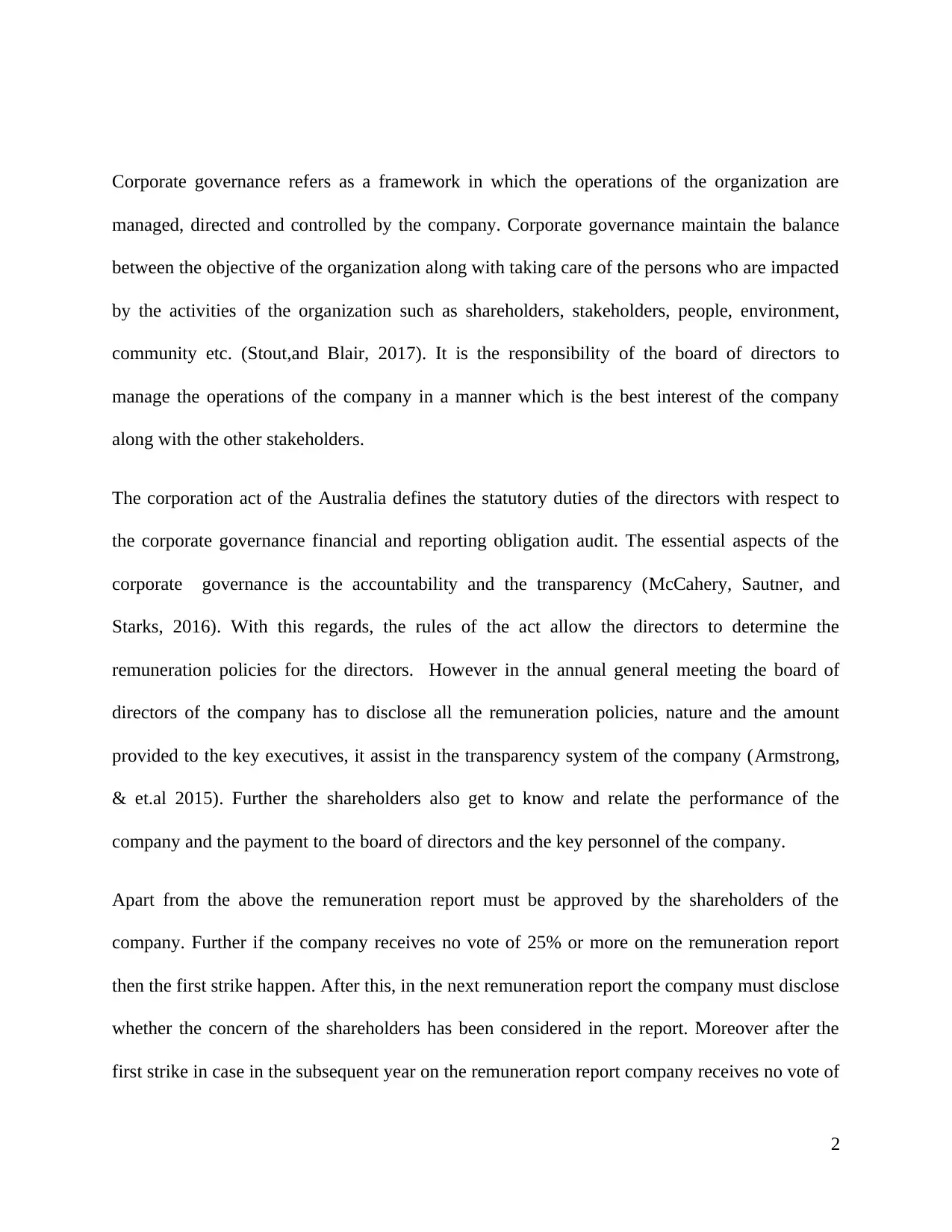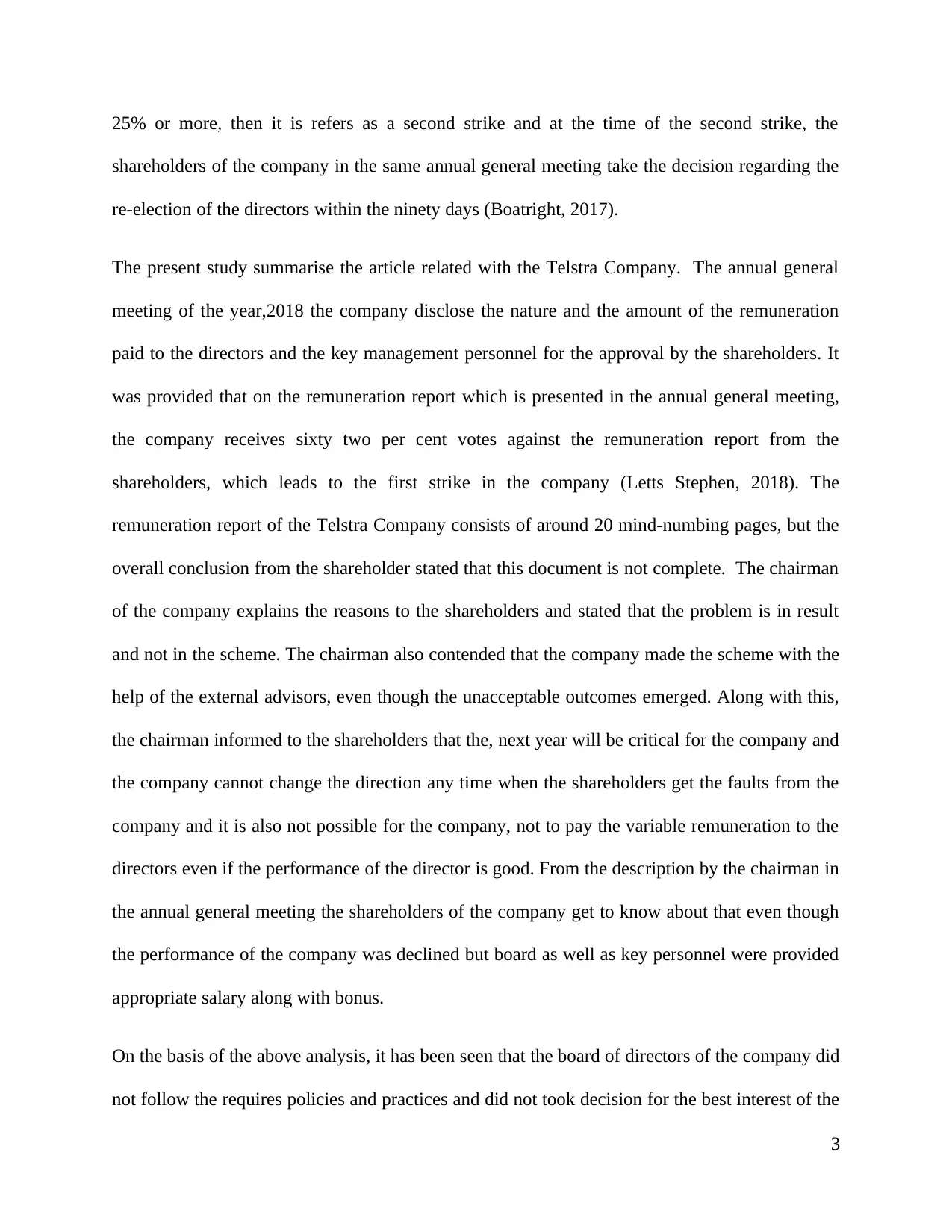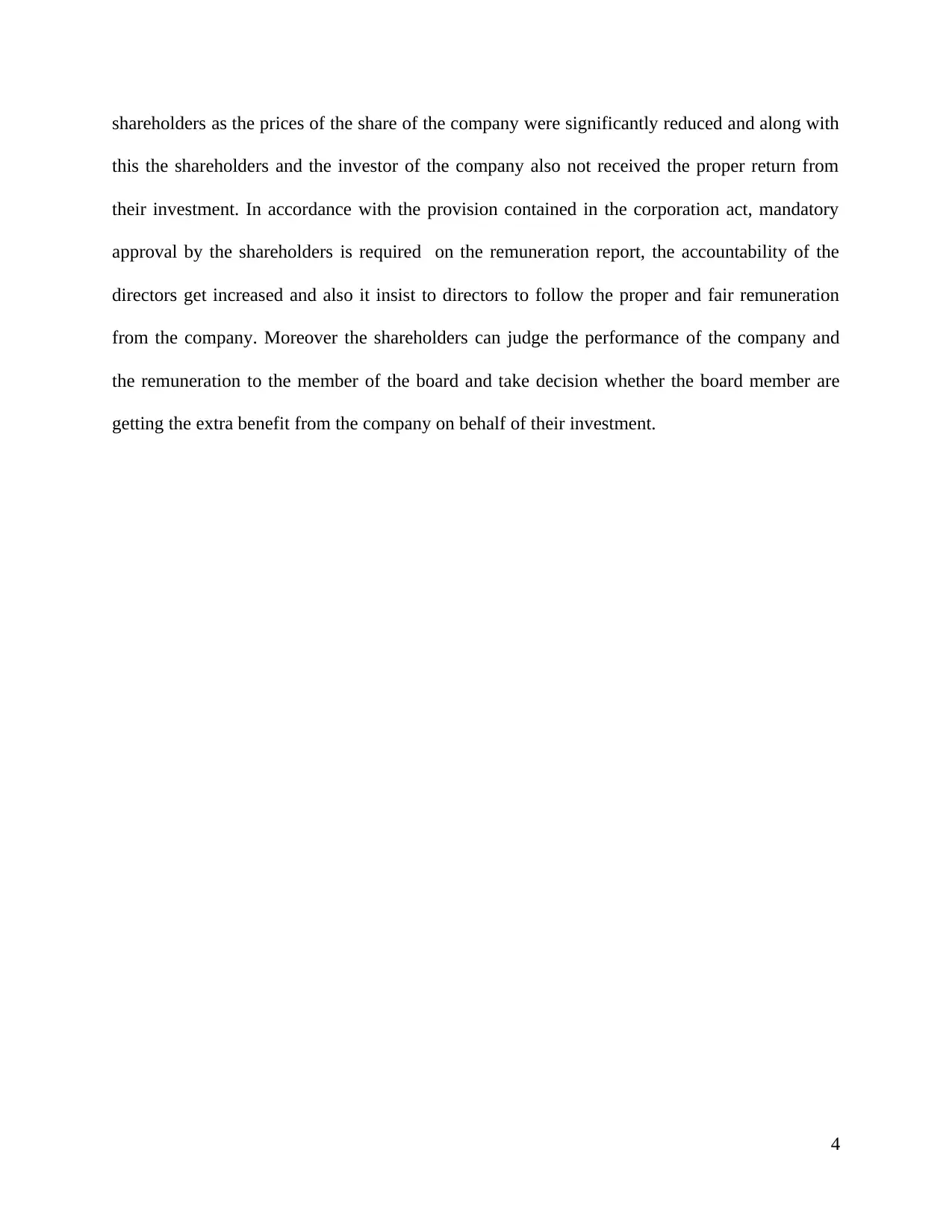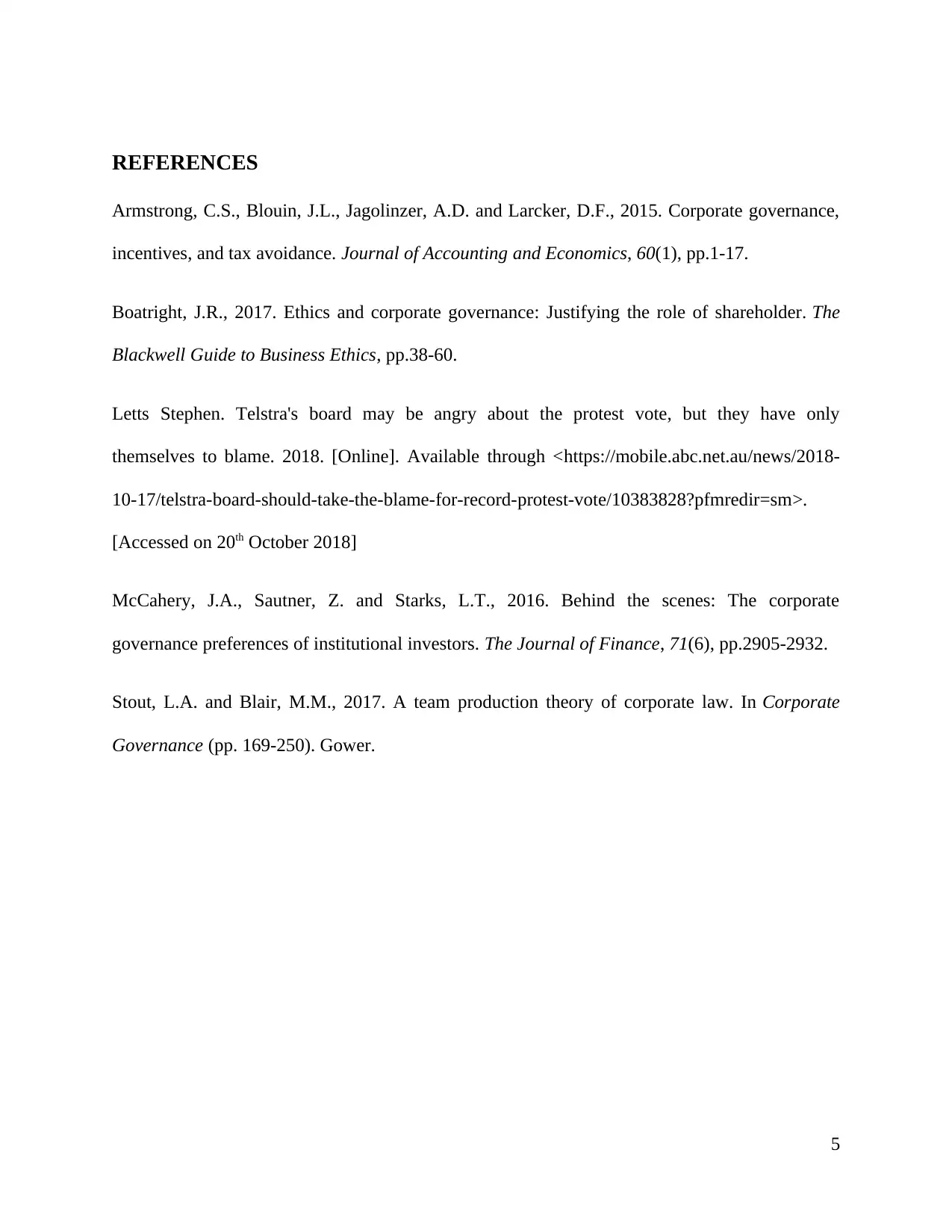Business and Corporation Law Assignment: Corporate Governance Analysis
VerifiedAdded on 2023/06/04
|5
|1026
|341
Report
AI Summary
This report analyzes corporate governance, focusing on the Telstra case study from 2018. It examines the company's remuneration report, which faced significant shareholder opposition (62% against) due to concerns about executive compensation despite declining performance. The report details the roles and responsibilities of the board of directors, as defined by the Australian Corporations Act, particularly concerning financial reporting, accountability, and transparency. It highlights the 'first strike' mechanism where shareholder disapproval triggers further scrutiny of remuneration practices. The analysis reveals that the board did not adequately prioritize shareholder interests, leading to reduced share prices and poor returns on investment. The study emphasizes the importance of shareholder approval on remuneration reports to increase director accountability and ensure fair compensation practices, as outlined in the Corporations Act. The report references key academic sources supporting the analysis.

BUSINESS AND CORPORATION LAW
1
1
Paraphrase This Document
Need a fresh take? Get an instant paraphrase of this document with our AI Paraphraser

Corporate governance refers as a framework in which the operations of the organization are
managed, directed and controlled by the company. Corporate governance maintain the balance
between the objective of the organization along with taking care of the persons who are impacted
by the activities of the organization such as shareholders, stakeholders, people, environment,
community etc. (Stout,and Blair, 2017). It is the responsibility of the board of directors to
manage the operations of the company in a manner which is the best interest of the company
along with the other stakeholders.
The corporation act of the Australia defines the statutory duties of the directors with respect to
the corporate governance financial and reporting obligation audit. The essential aspects of the
corporate governance is the accountability and the transparency (McCahery, Sautner, and
Starks, 2016). With this regards, the rules of the act allow the directors to determine the
remuneration policies for the directors. However in the annual general meeting the board of
directors of the company has to disclose all the remuneration policies, nature and the amount
provided to the key executives, it assist in the transparency system of the company (Armstrong,
& et.al 2015). Further the shareholders also get to know and relate the performance of the
company and the payment to the board of directors and the key personnel of the company.
Apart from the above the remuneration report must be approved by the shareholders of the
company. Further if the company receives no vote of 25% or more on the remuneration report
then the first strike happen. After this, in the next remuneration report the company must disclose
whether the concern of the shareholders has been considered in the report. Moreover after the
first strike in case in the subsequent year on the remuneration report company receives no vote of
2
managed, directed and controlled by the company. Corporate governance maintain the balance
between the objective of the organization along with taking care of the persons who are impacted
by the activities of the organization such as shareholders, stakeholders, people, environment,
community etc. (Stout,and Blair, 2017). It is the responsibility of the board of directors to
manage the operations of the company in a manner which is the best interest of the company
along with the other stakeholders.
The corporation act of the Australia defines the statutory duties of the directors with respect to
the corporate governance financial and reporting obligation audit. The essential aspects of the
corporate governance is the accountability and the transparency (McCahery, Sautner, and
Starks, 2016). With this regards, the rules of the act allow the directors to determine the
remuneration policies for the directors. However in the annual general meeting the board of
directors of the company has to disclose all the remuneration policies, nature and the amount
provided to the key executives, it assist in the transparency system of the company (Armstrong,
& et.al 2015). Further the shareholders also get to know and relate the performance of the
company and the payment to the board of directors and the key personnel of the company.
Apart from the above the remuneration report must be approved by the shareholders of the
company. Further if the company receives no vote of 25% or more on the remuneration report
then the first strike happen. After this, in the next remuneration report the company must disclose
whether the concern of the shareholders has been considered in the report. Moreover after the
first strike in case in the subsequent year on the remuneration report company receives no vote of
2

25% or more, then it is refers as a second strike and at the time of the second strike, the
shareholders of the company in the same annual general meeting take the decision regarding the
re-election of the directors within the ninety days (Boatright, 2017).
The present study summarise the article related with the Telstra Company. The annual general
meeting of the year,2018 the company disclose the nature and the amount of the remuneration
paid to the directors and the key management personnel for the approval by the shareholders. It
was provided that on the remuneration report which is presented in the annual general meeting,
the company receives sixty two per cent votes against the remuneration report from the
shareholders, which leads to the first strike in the company (Letts Stephen, 2018). The
remuneration report of the Telstra Company consists of around 20 mind-numbing pages, but the
overall conclusion from the shareholder stated that this document is not complete. The chairman
of the company explains the reasons to the shareholders and stated that the problem is in result
and not in the scheme. The chairman also contended that the company made the scheme with the
help of the external advisors, even though the unacceptable outcomes emerged. Along with this,
the chairman informed to the shareholders that the, next year will be critical for the company and
the company cannot change the direction any time when the shareholders get the faults from the
company and it is also not possible for the company, not to pay the variable remuneration to the
directors even if the performance of the director is good. From the description by the chairman in
the annual general meeting the shareholders of the company get to know about that even though
the performance of the company was declined but board as well as key personnel were provided
appropriate salary along with bonus.
On the basis of the above analysis, it has been seen that the board of directors of the company did
not follow the requires policies and practices and did not took decision for the best interest of the
3
shareholders of the company in the same annual general meeting take the decision regarding the
re-election of the directors within the ninety days (Boatright, 2017).
The present study summarise the article related with the Telstra Company. The annual general
meeting of the year,2018 the company disclose the nature and the amount of the remuneration
paid to the directors and the key management personnel for the approval by the shareholders. It
was provided that on the remuneration report which is presented in the annual general meeting,
the company receives sixty two per cent votes against the remuneration report from the
shareholders, which leads to the first strike in the company (Letts Stephen, 2018). The
remuneration report of the Telstra Company consists of around 20 mind-numbing pages, but the
overall conclusion from the shareholder stated that this document is not complete. The chairman
of the company explains the reasons to the shareholders and stated that the problem is in result
and not in the scheme. The chairman also contended that the company made the scheme with the
help of the external advisors, even though the unacceptable outcomes emerged. Along with this,
the chairman informed to the shareholders that the, next year will be critical for the company and
the company cannot change the direction any time when the shareholders get the faults from the
company and it is also not possible for the company, not to pay the variable remuneration to the
directors even if the performance of the director is good. From the description by the chairman in
the annual general meeting the shareholders of the company get to know about that even though
the performance of the company was declined but board as well as key personnel were provided
appropriate salary along with bonus.
On the basis of the above analysis, it has been seen that the board of directors of the company did
not follow the requires policies and practices and did not took decision for the best interest of the
3
⊘ This is a preview!⊘
Do you want full access?
Subscribe today to unlock all pages.

Trusted by 1+ million students worldwide

shareholders as the prices of the share of the company were significantly reduced and along with
this the shareholders and the investor of the company also not received the proper return from
their investment. In accordance with the provision contained in the corporation act, mandatory
approval by the shareholders is required on the remuneration report, the accountability of the
directors get increased and also it insist to directors to follow the proper and fair remuneration
from the company. Moreover the shareholders can judge the performance of the company and
the remuneration to the member of the board and take decision whether the board member are
getting the extra benefit from the company on behalf of their investment.
4
this the shareholders and the investor of the company also not received the proper return from
their investment. In accordance with the provision contained in the corporation act, mandatory
approval by the shareholders is required on the remuneration report, the accountability of the
directors get increased and also it insist to directors to follow the proper and fair remuneration
from the company. Moreover the shareholders can judge the performance of the company and
the remuneration to the member of the board and take decision whether the board member are
getting the extra benefit from the company on behalf of their investment.
4
Paraphrase This Document
Need a fresh take? Get an instant paraphrase of this document with our AI Paraphraser

REFERENCES
Armstrong, C.S., Blouin, J.L., Jagolinzer, A.D. and Larcker, D.F., 2015. Corporate governance,
incentives, and tax avoidance. Journal of Accounting and Economics, 60(1), pp.1-17.
Boatright, J.R., 2017. Ethics and corporate governance: Justifying the role of shareholder. The
Blackwell Guide to Business Ethics, pp.38-60.
Letts Stephen. Telstra's board may be angry about the protest vote, but they have only
themselves to blame. 2018. [Online]. Available through <https://mobile.abc.net.au/news/2018-
10-17/telstra-board-should-take-the-blame-for-record-protest-vote/10383828?pfmredir=sm>.
[Accessed on 20th October 2018]
McCahery, J.A., Sautner, Z. and Starks, L.T., 2016. Behind the scenes: The corporate
governance preferences of institutional investors. The Journal of Finance, 71(6), pp.2905-2932.
Stout, L.A. and Blair, M.M., 2017. A team production theory of corporate law. In Corporate
Governance (pp. 169-250). Gower.
5
Armstrong, C.S., Blouin, J.L., Jagolinzer, A.D. and Larcker, D.F., 2015. Corporate governance,
incentives, and tax avoidance. Journal of Accounting and Economics, 60(1), pp.1-17.
Boatright, J.R., 2017. Ethics and corporate governance: Justifying the role of shareholder. The
Blackwell Guide to Business Ethics, pp.38-60.
Letts Stephen. Telstra's board may be angry about the protest vote, but they have only
themselves to blame. 2018. [Online]. Available through <https://mobile.abc.net.au/news/2018-
10-17/telstra-board-should-take-the-blame-for-record-protest-vote/10383828?pfmredir=sm>.
[Accessed on 20th October 2018]
McCahery, J.A., Sautner, Z. and Starks, L.T., 2016. Behind the scenes: The corporate
governance preferences of institutional investors. The Journal of Finance, 71(6), pp.2905-2932.
Stout, L.A. and Blair, M.M., 2017. A team production theory of corporate law. In Corporate
Governance (pp. 169-250). Gower.
5
1 out of 5
Related Documents
Your All-in-One AI-Powered Toolkit for Academic Success.
+13062052269
info@desklib.com
Available 24*7 on WhatsApp / Email
![[object Object]](/_next/static/media/star-bottom.7253800d.svg)
Unlock your academic potential
Copyright © 2020–2025 A2Z Services. All Rights Reserved. Developed and managed by ZUCOL.




